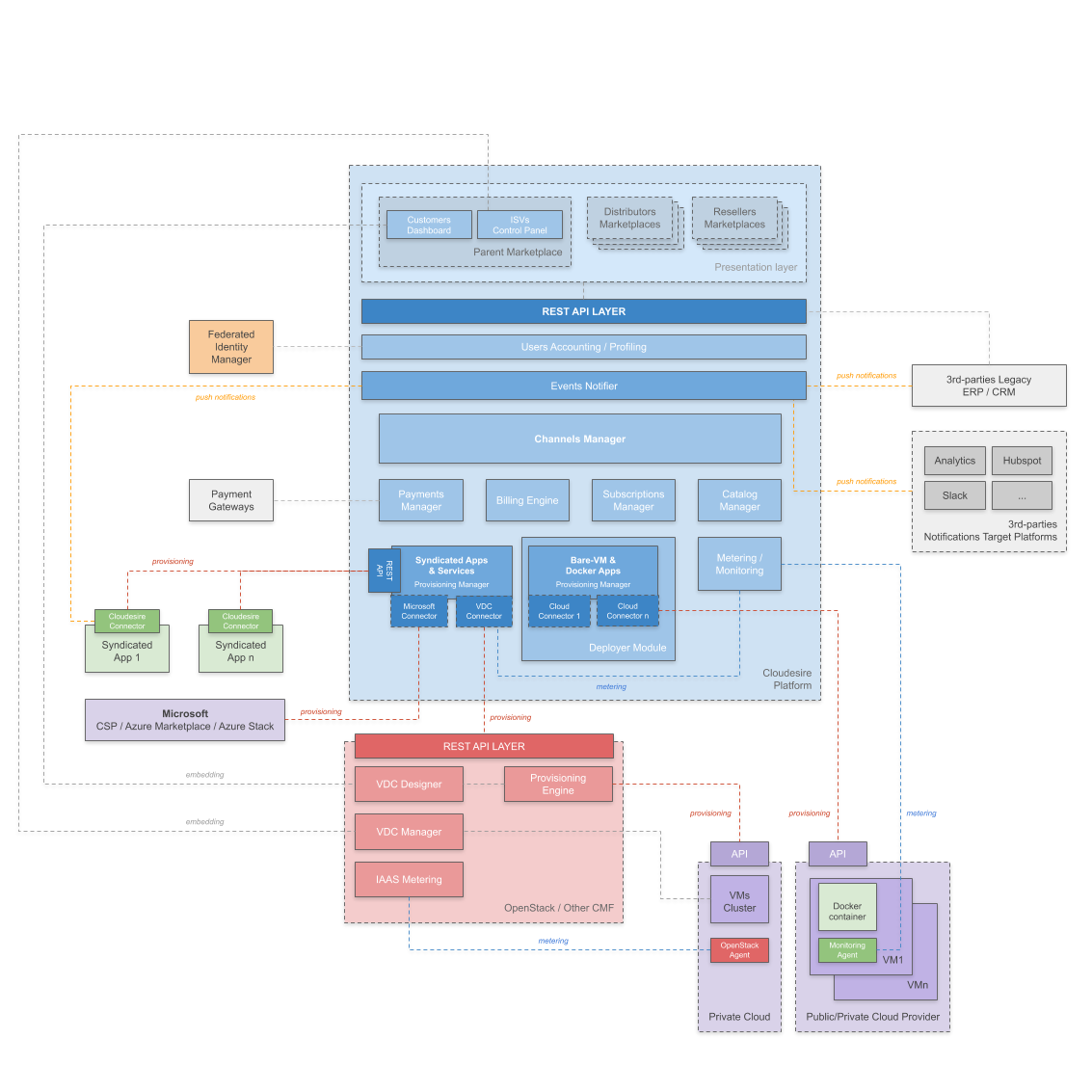Platform modules

The main components of the Cloudesire platform can be summarized as follows:
- Backend: it represents the "core" of the platform and consists in a set of independent multi-thread modules that uses messaging queues to enable asynchronous, distributed and redundant messaging among components, allowing enterprise integration patterns. Each module exposes a REST API that is used consumed by the other modules and by the web interfaces.
- Control panel: a responsive web application that allows users to manage different entities, according to their role: customers can see their orders status and check availability of their instances; vendors can manage their application catalog, active customers, orders and running instances of their applications; administrator can manage the entire platform and receive updates from the monitoring and alerting systems.
- Marketplace: a responsive web application where a software vendor can publish its own products, along with others vendors products. Customers can browse the catalog, compare products, rate and comment them, place orders or try an application (if the vendor allows it).
Backend
Cloudesire backend is composed by the following modules:
- CMW: the core of Cloudesire, handles most of the business logic related to the catalog, customers, subscriptions and billing. CMW also includes the Persistence Layer: a PostgreSQL database managing all the relational entities of the platform (as regards the additional resources, such logos, screenshots, etc. the platform typically leverages a dedicated Object Storage, like for example a platform owner's AWS S3 tenant).
- Deployer: manages cloud resources for BareVMs. The deployment process is described in the next chapter. It leverages open-source libraries (e.g. jclouds) and cloud SDKs to connect via API to Public and Private cloud providers.
- Monitor: an API that exposes system and application for statistics and real-time graphs. Data store is based on the open-source Prometheus monitoring system. System metrics are collected via the open-source node-exporter
- Metrics-exporter: hook bandwidth metrics gathered from public cloud providers into the Monitor for pay-per-use bandwidth consumption.
- Logger: an API that expose VM logs. Data store is based on the open-source graylog logging platform.
- Marketplace-api: enables real-time customization of parent, distribution and reseller marketplaces (logo, description, theme, etc.)
- Hubspot-connector: allows the integration of Cloudesire user-base into the Hubspot CRM
- Feedback-api: an API to collect user support requests and forward them to ticket systems.
- Keycloak: enables SSO capabilities for marketplace users
- cassetto: manage catalog resources (logos, screenshots, etc.) on object storage systems.
- Janine: open-source PDF invoice generator
- Vivace: API to calculate a background color from an image (used for products logo into the marketplace)
Available integrations
There is a list of available integrations.
Deployer workflow
Deployer implements a state-machine to manage the deployment process on a specific cloud provider, following this workflow for BareVM products:
- Check prerequisites, depending on the cloud provider, e.g. existence of a particular network, management of ssh key, security groups and general firewall rules
- Creates a new VM (through the cloud provider APIs), having a specific "size" defined by the vendor (i.e. 2 cores, 1GB RAM)
- Customer SSH public key login is configured
- Creates and attaches a data disk to the VM, where application and user data can be stored
- End-user receives a notification (via email and in its own control panel interface) with all the instructions needed to access its own instance of the application he paid for (URL, default login and password)
Deployer also manages the provisioning of bare VM products, but in this case no data disk will be attached and no configuration take place into the VM.
